AI and Biological Controls: How They Work Together
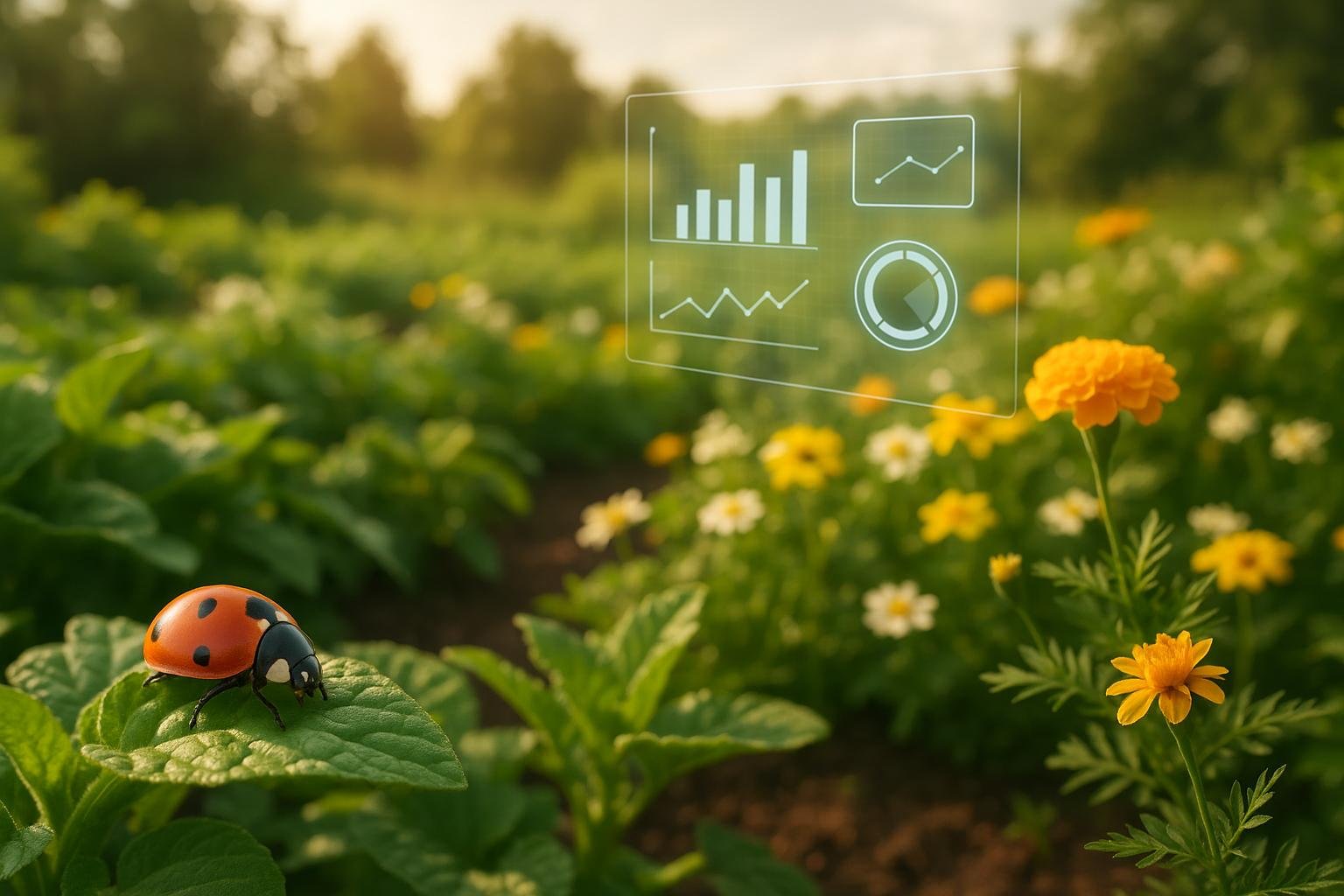
AI and biological pest control are changing how we manage pests while protecting the environment.
- AI tools predict pest outbreaks with up to 92% accuracy, analyze weather patterns, and monitor pests using sensors and drones.
- Biological controls use natural predators like ladybugs, parasitic wasps, and beneficial microorganisms to manage pests without harmful chemicals.
- Together, AI enhances the timing and precision of deploying these natural solutions, reducing pest damage and chemical use by up to 70%.
For example, AI systems can warn about aphid outbreaks two weeks in advance, allowing gardeners to release ladybugs at the perfect time. This combination creates healthier gardens, cuts costs, and minimizes environmental harm.
Keep reading to learn how to integrate AI and biological controls into your garden and make pest management smarter and safer.
AI and Biocontrol: Partnering with Nature for Pest Management! Part 1 #ai #viral #trending

What Are Biological Controls
Biological pest control relies on living organisms to manage harmful insects and diseases. Every pest has its natural enemies, and by tapping into these relationships, we can create a balanced, self-regulating ecosystem. Instead of turning to synthetic chemicals, this approach uses predators, parasites, and beneficial microorganisms to keep pest populations in check [5].
Take toads, for example - a single one can eat up to 15,000 insects [6]. This natural pest control method focuses on promoting these helpful organisms to keep pest numbers below harmful levels. Unlike broad-spectrum pesticides, which can harm beneficial species, biological controls are precise and continue to work over time once they’re established. The goal isn’t to eliminate pests entirely but to maintain their populations at levels that don’t cause significant damage to plants.
Types of Biological Control Methods
Biological pest control typically involves three main strategies:
- Classical control: This method introduces natural enemies from a pest's original habitat for long-term regulation. A famous example is the introduction of the cactus moth (Cactoblastis cactorum) in Queensland, Australia, to combat prickly pear cacti, which had spread across more than 61 million acres (about 25 million hectares) by 1920 [7].
- Augmentative control: This approach involves releasing additional natural enemies to strengthen existing populations or provide temporary pest control. For example, gardeners often release ladybugs to manage aphids or use beneficial nematodes to target soil-dwelling pests.
- Conservation control: This strategy focuses on protecting and encouraging natural enemies already present in the environment. It may include providing food, water, and shelter for beneficial insects while limiting pesticide use to avoid harming them [6].
| Type of Biological Control Agent | Examples | Role |
|---|---|---|
| Predatory Insects | Ladybugs, lacewings, gall midges | Prey on pests like aphids, whiteflies, mealybugs, and caterpillars [3] |
| Predatory Mites | Phytoseiulus persimilis, Neoseius californicus | Target pest mites and small insects such as spider mites, whiteflies, and thrips [7] |
| Parasitic Wasps | Encarsia formosa, Trichogramma | Lay eggs in or on pests; larvae consume and kill the host [7] |
| Beneficial Nematodes | Steinernema and Heterorhabditis | Attack soil-dwelling pests by releasing bacteria that kill the host [3] |
| Beneficial Microorganisms | Bacillus thuringiensis, Beauveria bassiana | Infect and kill various insect pests [7] |
Some biological control agents are impressively efficient. For instance, hoverfly larvae can consume up to 400 aphids during their lifetime [7]. In Spain, the predatory mite Amblyseius swirskii has successfully managed pests in honey melon and eggplant production [9]. Meanwhile, in Brazil, the egg parasitoid Trichogramma pretiosum has proven effective against Cotton Bollworm pests [9]. These examples highlight how biological controls can deliver precise pest management while promoting sustainable gardening practices.
Benefits of Biological Pest Control
Biological pest control brings a range of advantages, including environmental safety, cost savings, and long-term effectiveness. One of its greatest strengths is environmental safety - these methods don’t harm plants or leave behind toxic residues, unlike chemical pesticides [8]. Beneficial insects alone provide an estimated $4.5 billion worth of pest control services each year [10].
Because biological controls are highly specific to their target pests, they minimize risks to other beneficial insects, pets, and humans. For example, studies in rice fields have shown that planting nectar-producing border plants can reduce pest populations by 10- to 100-fold, cutting insecticide use by 70% and increasing crop yields by 5% [7].
Another major perk is the lasting impact of these methods. Once natural enemies are established, they often continue to work year after year, becoming even more effective as their populations stabilize. This creates resilient ecosystems that adapt to changes without requiring constant intervention.
Economic benefits also add up over time. With fewer pesticide applications needed, costs decrease significantly. A striking example is the World Mosquito Program, which used Wolbachia-infected mosquitoes in Colombia to reduce dengue cases by 94–97% in several cities [7]. This demonstrates how biological control can even tackle complex public health issues.
Additionally, pests are less likely to develop resistance to their natural enemies, unlike with chemical pesticides. This means biological controls remain effective over the long term. Considering that pesticide poisoning affects an estimated 3 million people worldwide each year [11], these methods offer a safer alternative for families, pets, and the environment. By building on nature’s strengths, biological pest control lays the groundwork for healthier and more sustainable gardening practices.
How AI Improves Biological Pest Control
Artificial intelligence is transforming biological pest control by fine-tuning the timing, placement, and strategies for using beneficial insects. Instead of replacing these natural allies, AI enhances their effectiveness, ensuring they deliver maximum impact with minimal disruption to the environment. For instance, AI systems can predict pest outbreaks with an impressive 85% accuracy and anticipate unusual population spikes with over 30% better precision[12]. This means gardeners can release beneficial insects at just the right moment - before pests multiply out of control - making these biological solutions significantly more effective. This precise, low-spray method sets the stage for the advanced AI prediction and monitoring techniques discussed below.
AI Pest and Disease Prediction
AI-powered prediction models combine data like weather patterns, pest life cycles, and plant health to forecast outbreaks before they become visible. By analyzing aerial imagery and sensor data, AI can detect subtle changes in vegetation and alert gardeners early, enabling them to act quickly with biological controls.
One example is the "Pest Forecast" platform developed by the Commonwealth Scientific and Industrial Research Organisation (CSIRO) in Australia. This system uses machine learning to predict pest activity based on weather forecasts and historical trends, allowing farmers to take action before infestations escalate[1]. Similarly, Tamil Nadu Agricultural University (TNAU) has created an Android app that identifies fall armyworm infestations in maize crops using advanced neural networks. The app boasts 93.47% validation accuracy and 98.47% training accuracy, making it a powerful tool for pest management.
Predictive software can achieve accuracy rates of up to 92% when forecasting pest activity[13]. For example, if AI predicts an aphid outbreak two weeks in advance based on temperature and humidity trends, gardeners can release ladybugs or lacewings right before the pests surge. This proactive approach ensures that beneficial insects are deployed when they can have the greatest impact, keeping pest populations manageable.
As climate change disrupts traditional weather patterns, historical pest calendars are becoming less reliable. AI adapts to these changes by continuously learning from new data, helping gardeners stay ahead of shifting pest pressures.
AI Monitoring and Analysis Tools
AI-powered tools for real-time monitoring - such as sensors, cameras, and drones - offer unmatched surveillance capabilities, identifying pest issues long before they become severe.
For instance, Trapview, developed by EFOS Ltd., uses pheromone traps equipped with IoT-enabled cameras and sensors. AI algorithms analyze the collected data to monitor pest activity in orchards and vineyards, providing timely insights for intervention[1]. These traps capture images of trapped insects, allowing AI to predict pest spread and guide field technicians in taking precise, targeted actions.
Drones equipped with AI imaging can scan large garden areas to identify problem spots. This targeted approach can reduce chemical use by up to 90% compared to traditional spraying methods[13]. For biological pest control, this means releasing beneficial insects only in affected areas rather than blanketing an entire garden.
AI tools also monitor the effectiveness of biological controls after their release. Sensors track pest population changes, beneficial insect activity, and plant health, offering real-time feedback to refine pest management strategies. Over time, this continuous data loop helps gardeners fine-tune their approach.
"Data is the backbone of AI", – Inupa Bandara, AI industry expert [2]
AI systems can reduce the time spent identifying harmful species by nearly 70% compared to traditional methods, freeing up gardeners to focus on deploying biological controls[12]. Regions using predictive analytics have seen a 30% reduction in crop losses[12]. By delivering precise, real-time insights on pest activity and environmental conditions, AI enables gardeners to use beneficial insects more effectively and efficiently.
sbb-itb-4d6a8dd
🚀 Ready to Reinvent Your Garden?
Join thousands of homeowners who have transformed their gardens using our AI design tool. Upload one photo to explore endless possibilities.
Get your AI garden designs →Combining AI and Biological Controls in Your Garden
Blend the power of AI with biological pest control to create a smart, round-the-clock pest management system. By combining advanced monitoring tools with natural predators, you can achieve effective and eco-friendly pest control.
Step-by-Step Integration Guide
Start by building a foundation with AI-powered monitoring. Install smart sensors to track soil moisture, temperature, humidity, and light levels. These sensors provide early alerts for potential pest problems, often before they become visible.
Next, use AI-driven mobile apps to quickly identify pests and diseases through smartphone photos. For instance, the PestID app from the University of Georgia uses AI to identify insects from images, offering details on pest biology and management strategies [1]. Similarly, the PestNet app from the Food and Agriculture Organization (FAO) allows users to report plant diseases and pests by sharing photos, which are then verified by a network of specialists [1].
For ongoing pest monitoring, incorporate trap systems equipped with optical sensors and machine learning. Companies like Farmsense have developed tools like FlightSensor, which tracks insect populations in real time using these technologies [14].
Once your AI system identifies potential pest outbreaks, deploy beneficial insects in response to its predictions. For example, if sensors detect rising aphid populations based on temperature and humidity patterns, release natural predators like ladybugs or lacewings before the infestation escalates.
Thermal imaging can also be a game-changer. This technology helps detect pest or bacterial attacks by analyzing changes in plant temperature. The "Kishan Know" system, developed in 2021 by researchers at VIT-Chennai Campus, uses thermal imagery to spot early signs of pest or bacterial issues, enabling immediate action [14].
Finally, track pest reduction and plant health using AI analytics. By analyzing population data and plant health metrics, you can fine-tune future interventions, ensuring the right timing and quantities for releasing beneficial insects.
Align these AI-driven strategies with your garden layout to maximize pest control and overall plant health.
Using AI Garden Design Tools
With your monitoring and intervention systems in place, strengthen your garden’s defenses through smart design.
AI garden design platforms can help you optimize plant placement and species selection to naturally resist pests. For example, AIGardenPlanner offers tools to create personalized garden layouts. Its AI Plant Advisor suggests plant varieties suited to your location and climate, many of which are naturally resistant to common pests. The platform also allows you to choose from over 50 garden styles and incorporate companion planting strategies - where certain plants protect others from pest damage.
Detailed growing guides and maintenance schedules from these tools make it easier to coordinate biological control releases with plant growth stages. For instance, if your garden plan highlights peak flowering periods for plants that attract beneficial insects, you can time the release of predatory insects to establish lasting populations.
AI tools also help optimize sunlight exposure and plant spacing, reducing conditions like high humidity that encourage pests. Additionally, thoughtfully placed flowering plants can create pathways that support beneficial insects as they move through your garden.
Predictive planting schedules further enhance pest control. AI planners can recommend planting dates based on local climate patterns and pest life cycles. This ensures plants are established when they’re least vulnerable to pests, reducing the need for intensive interventions.
"We've built the biggest database of pictures of insects in the world, which allows us to really use modern AI-based computing vision most optimally." - Matej Štefančič, CEO of Trapview [14]
Future of AI and Biological Controls
The field of AI-powered biological pest control is moving fast, reshaping the way we manage gardens and agricultural spaces. In fact, over 60% of new pest control patents now involve either AI or biological agents aimed at promoting sustainable agriculture [18].
Today's advanced AI systems can process enormous datasets to deliver precise recommendations. They can predict the best planting times, analyze soil moisture levels, and even track microclimates in your garden [16]. This technology is making it easier than ever to optimize growing conditions.
One exciting development is the integration of satellite technology with AI algorithms. This pairing allows gardeners to monitor plant health from above, spotting stress patterns and potential pest issues long before they’re visible at ground level [20]. It’s like having a bird’s-eye view of your garden’s health.
Automation is also taking center stage. For example, ecoRobotix's ARA sprayer uses AI to identify and treat individual plants, cutting chemical usage by as much as 95% [21]. Similarly, Niqo Robotics has rolled out its Niqo Sense™ AI camera system across more than 90,000 acres, reducing chemical use by up to 60% and directly benefiting over 1,800 farmers in India [21]. These advancements highlight how AI is blending eco-friendly methods with cutting-edge technology.
AI and Eco-Friendly Gardening Practices
AI is transforming sustainable gardening by promoting practices that lower environmental impact while boosting garden health. For instance, pilot projects have shown that AI-driven solutions can reduce chemical pesticide use by up to 40% [18].
Future sensors are expected to do even more. Beyond detecting pests, they’ll monitor entire ecosystems, keeping tabs on both harmful pests and beneficial insects. This kind of comprehensive tracking opens the door to smarter, more balanced gardening.
AI is also proving to be a great ally in biodiversity. By analyzing plant combinations, these platforms can recommend companion planting strategies that naturally repel pests and attract helpful insects. Fasal, an AI-driven platform, has already made waves by conserving over 82.8 billion liters of water while significantly reducing pesticide use [21].
Predictive analytics is another game-changer. By using AI and machine learning, gardeners can anticipate pest and disease outbreaks before they spiral out of control. This allows for timely deployment of biological controls, maximizing their effectiveness [4].
The market for biological control agents is on the rise, with projections showing growth from $3.73 billion to $5.25 billion. This shift reflects a growing preference for eco-friendly pest management solutions [19]. These innovations are not just improving current gardening practices but are also setting the stage for long-term efficiency and sustainability.
Long-Term Benefits of AI Integration
The long-term impact of combining AI with biological controls goes well beyond pest management. It offers gardeners ongoing improvements in efficiency, cost savings, and overall garden health.
One of the most exciting aspects of AI is its ability to learn and adapt. Over time, these systems gather data about your specific garden - its conditions, pest patterns, and plant responses. This allows them to deliver increasingly accurate and personalized recommendations tailored to your unique environment [16].
Cost savings are another major advantage. By preventing large-scale pest outbreaks and minimizing unnecessary pesticide use, AI-driven tools can lead to substantial financial benefits [4]. Considering that pests and diseases cause over $220 billion in global crop losses annually, even small improvements in pest control can make a big difference [4].
AI also takes over time-consuming tasks like monitoring schedules, treatment tracking, and data analysis. This automation frees up gardeners to focus on what they love most - actually tending to their plants [17].
"AI is not here to replace pest controllers, it's here to assist them. Technology can enhance operations, but the human element remains irreplaceable in client relationships, on-site inspections, and decision-making based on experience and intuition." – Jan Smits, General Manager of PestScan [17]
Looking ahead, tools like AIGardenPlanner promise to become even more advanced. These platforms will offer smarter plant recommendations and garden layouts designed for biological pest control. By integrating climate data, they’ll also help gardeners anticipate pest behavior based on weather changes, enabling adaptive, long-term strategies [4].
Finally, the integration of smart home technology with pest control systems is adding another layer of convenience. These systems provide automated, real-time monitoring and prevention, ensuring that beneficial insects and biological controls are deployed at just the right time. The result? Healthier, more resilient gardens that thrive with less effort [15].
Conclusion
The combination of AI and biological controls is reshaping the future of gardening, offering smarter and more sustainable ways to grow. By blending the precision of artificial intelligence with natural pest management techniques, gardeners can cultivate healthier ecosystems while cutting back on chemical use.
AI-driven pest management tools are proving to be game-changers, enabling quick detection of issues and promoting environmentally friendly solutions [16]. These advancements help gardeners maintain the delicate balance of their garden's ecosystem while ensuring optimal growing conditions [22].
"Embracing AI ensures greener practices today while paving the way for resilient gardening methods that protect our planet's future." – Dr. Alexander Tabibi, Entrepreneur, Investor, and Advocate for Sustainable Innovation [16]
This forward-thinking approach is now more accessible than ever. Tools like AIGardenPlanner make it simple for gardeners to adopt AI-powered solutions. With its AI Plant Advisor, the platform delivers tailored recommendations based on local climate, soil conditions, and user preferences, while also offering strategies for effective biological pest control [23].
By addressing potential issues early and providing eco-friendly treatment options, this comprehensive system empowers gardeners to protect their plants and the environment simultaneously [22].
As gardening continues to evolve, integrating AI with biological controls will play a central role in fostering resilient and sustainable practices. Whether you're new to gardening or a seasoned pro, adopting these technologies today can help you grow healthier plants and contribute to a greener future.
FAQs
How can AI and biological pest control work together in home gardening?
AI and natural pest control methods can work hand in hand to create thriving, eco-friendly gardens. With the help of AI-powered tools, gardeners can detect pests and plant diseases early through image recognition. This allows for swift, precise actions like releasing helpful insects or using organic remedies to address the problem.
Beyond pest management, AI can also assess critical factors such as soil quality, weather conditions, and overall plant health. With this information, gardeners can fine-tune practices like watering schedules and fertilization. This approach not only encourages natural pest control but also supports biodiversity and helps maintain a balanced garden ecosystem. By blending cutting-edge technology with sustainable techniques, gardeners can nurture healthier plants while being mindful of the environment.
What are the environmental advantages of using AI-powered biological pest control instead of chemical pesticides?
AI-driven biological pest control provides a greener alternative to chemical pesticides by cutting down on the use of synthetic chemicals. Traditional pest control methods often harm beneficial insects, disrupt wildlife, and damage ecosystems. In contrast, this AI-supported approach emphasizes natural methods that are safer for the environment.
AI enhances pest detection, making it more precise and allowing for focused interventions. This reduces the excessive use of chemicals, lessens pollution, and prevents harmful runoff. It also helps maintain biodiversity and promotes healthier soil and plants. By combining AI technology with biological pest control, farmers and gardeners can adopt a more sustainable and eco-conscious way to manage pests.
How does AI predict pest outbreaks, and how reliable are these predictions in different environments?
AI has the ability to forecast pest outbreaks by sifting through massive datasets. This includes everything from real-time weather conditions and historical pest activity to even the genetic makeup of pests. By spotting patterns and trends in this data, AI can predict when and where infestations are most likely to happen.
The reliability of these predictions hinges on the quality of the data being fed into the system. On average, AI models can hit about 85% accuracy. However, unexpected climate shifts or local environmental quirks can sometimes throw off these forecasts. Even with such challenges, these tools are proving to be a game-changer for gardeners and farmers, enabling them to stay ahead of pests and safeguard their crops.
🎨 Visualize Your Dream Garden Today!
Transform any outdoor space into a professional landscape design in minutes. Just upload a photo, choose your style, and let our AI do the rest.
Start your garden transformation now →Related posts
Related Articles
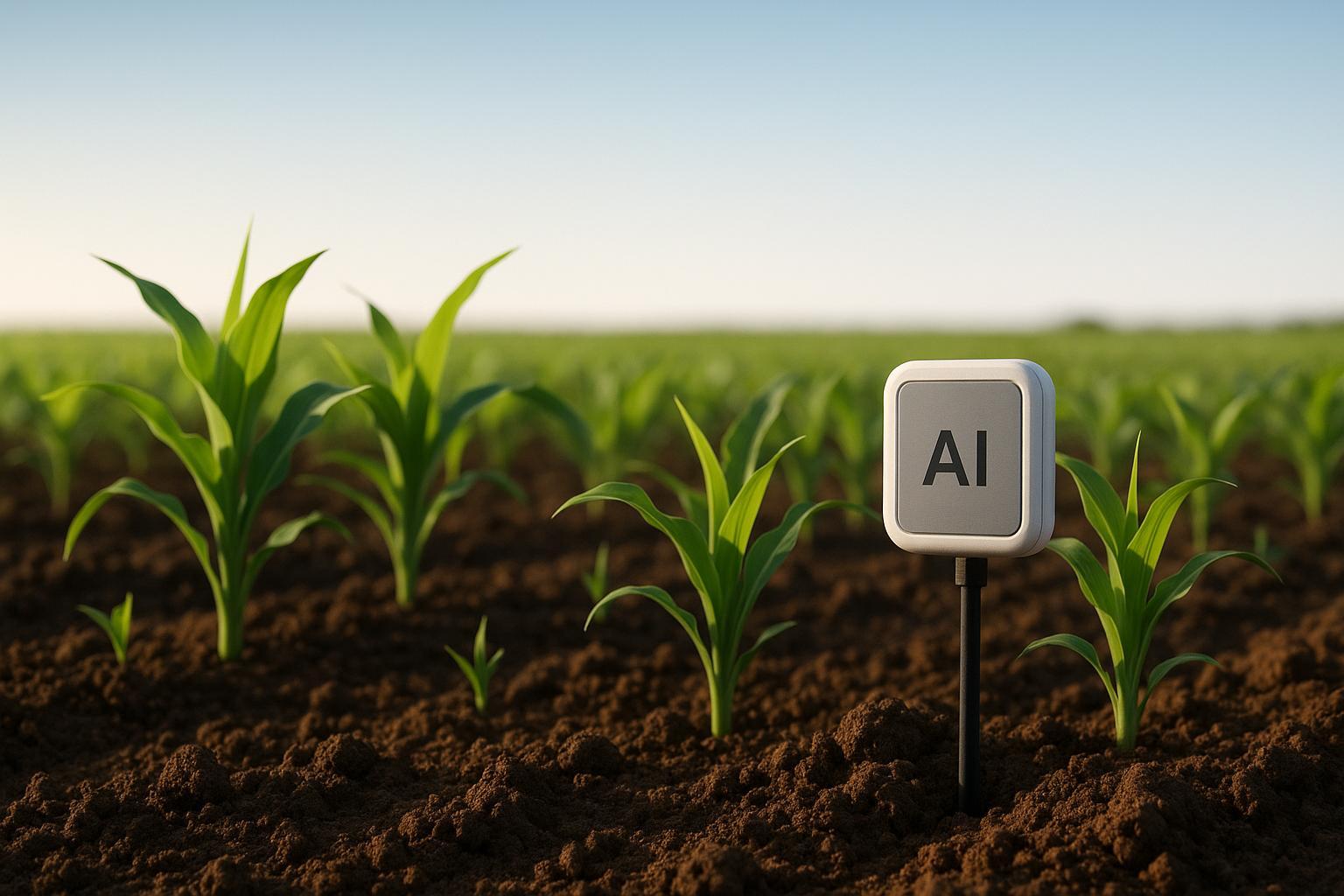
AI for Soil Water Retention Analysis
Explore how AI is revolutionizing soil water retention analysis, optimizing irrigation, and aiding in drought-resistant plant selection for sustainable gardening.
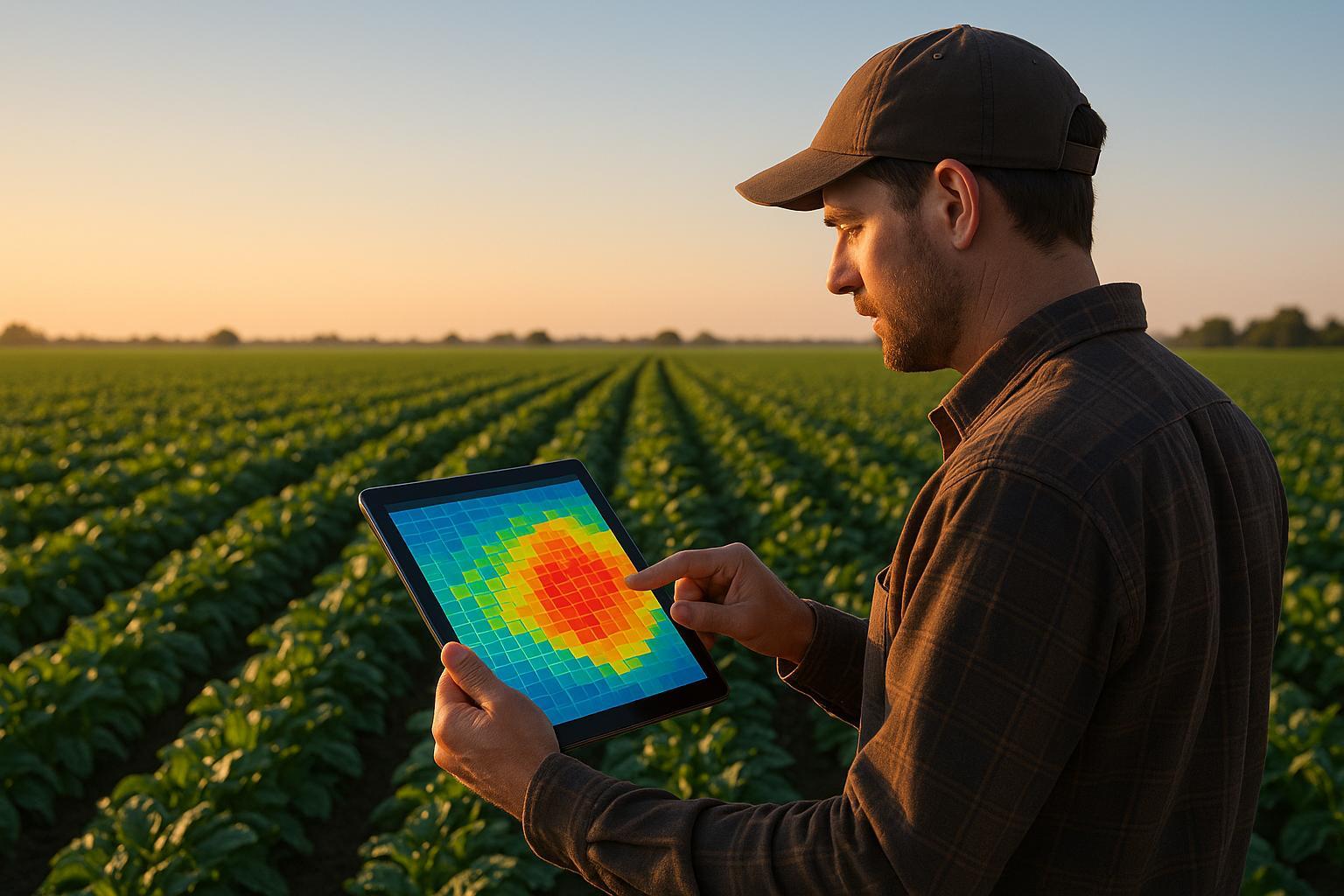
Growing Degree Days: AI's Role in Pest Control Timing
Explore how AI and Growing Degree Days enhance pest control timing, reducing pesticide use and increasing crop yields for sustainable agriculture.

How Multi-Sensor Systems Detect Plant Diseases
Explore how multi-sensor systems revolutionize plant disease detection with advanced technology, offering early insights and precise treatment strategies.
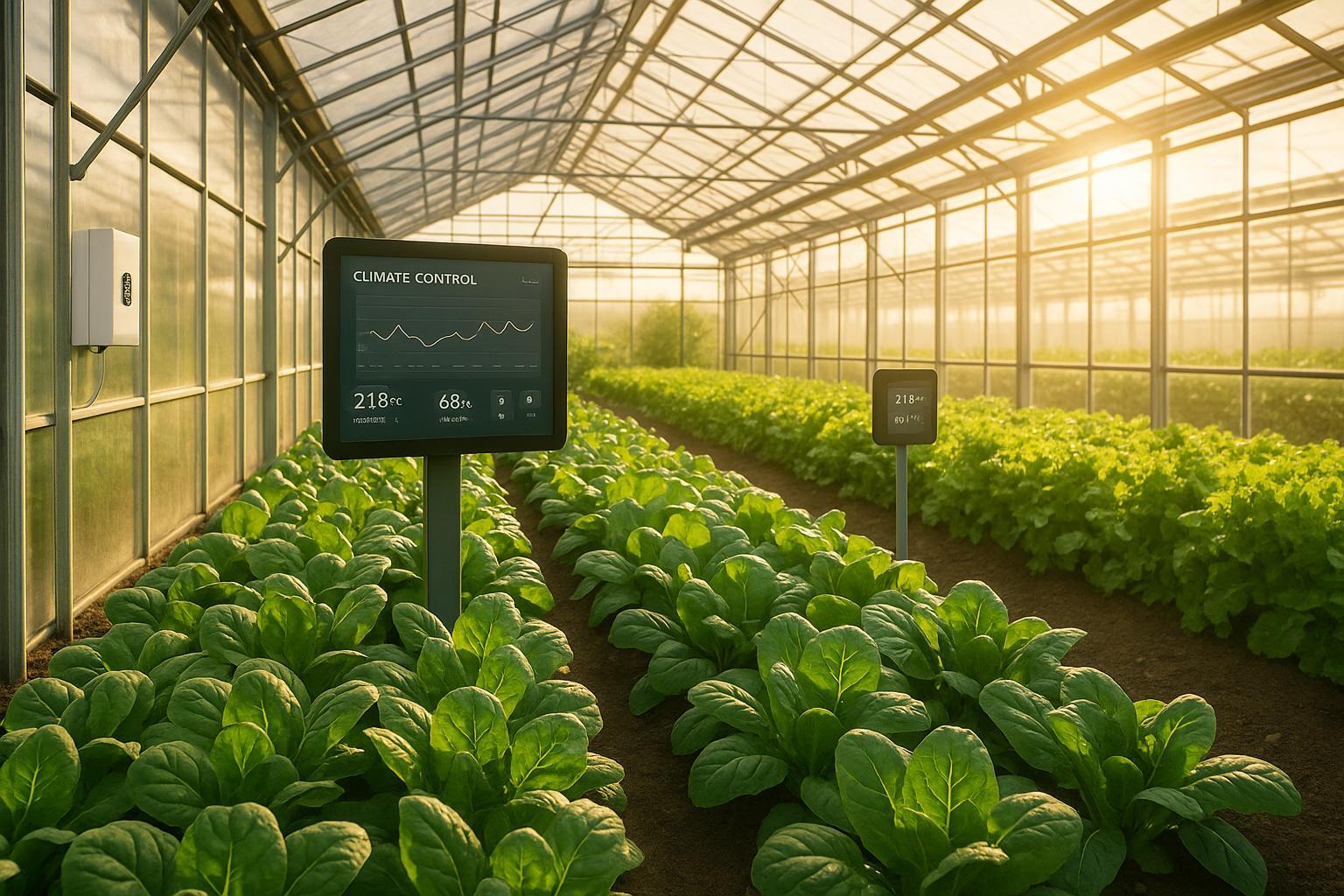
AI-Powered Greenhouse Climate Control Trends 2025
Explore how AI is revolutionizing greenhouse climate control, enhancing efficiency, and ensuring optimal crop health through advanced technologies.

Should You Detassel Your Corn? Factors to Consider
Explore the pros and cons of detasseling corn to make an informed decision. Learn about the impact on yield, pest control, labor, and corn quality.
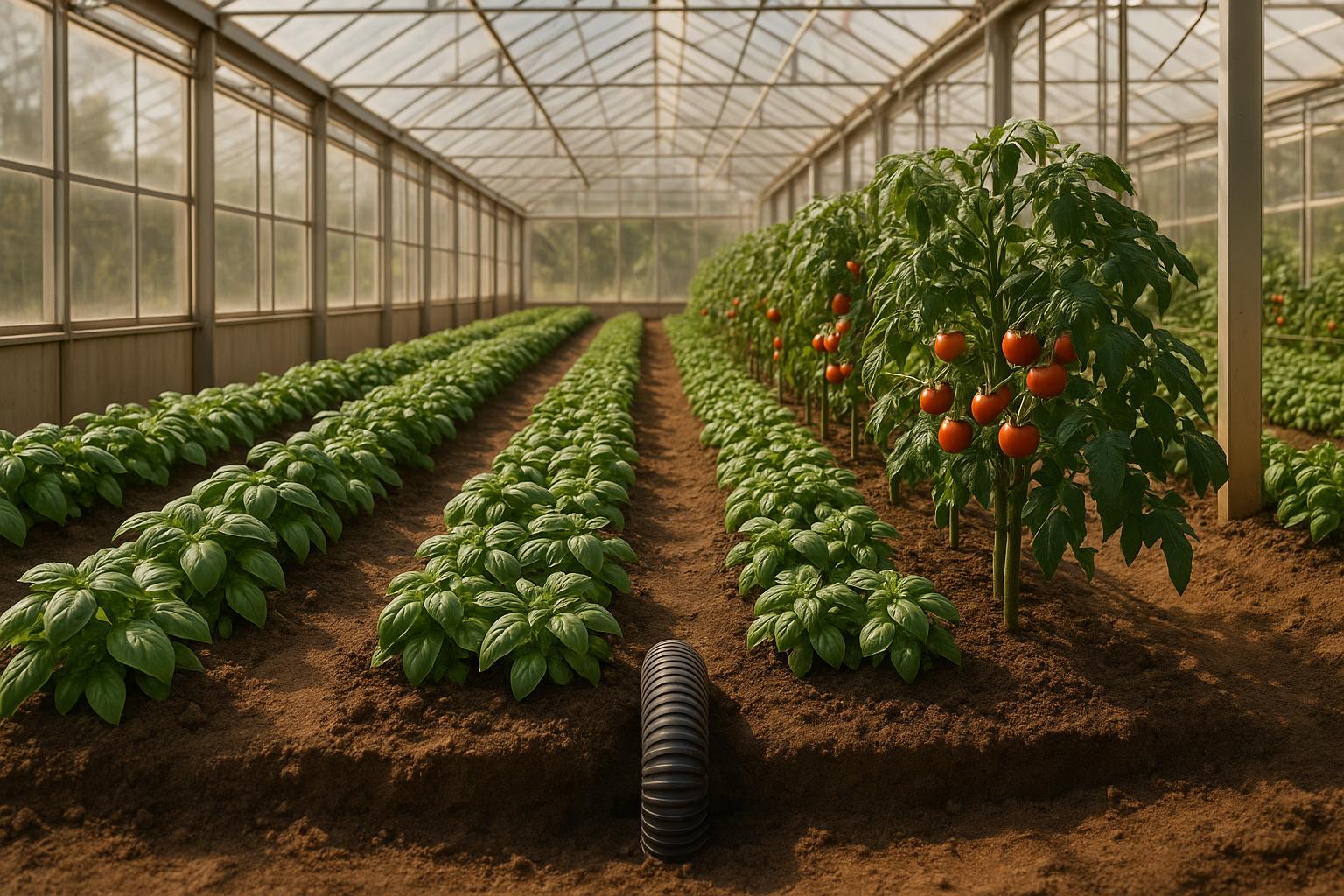
Companion Planting with Geothermal Climate Control
Explore how geothermal climate control enhances companion planting by creating optimal growing conditions, boosting yields, and reducing energy costs.